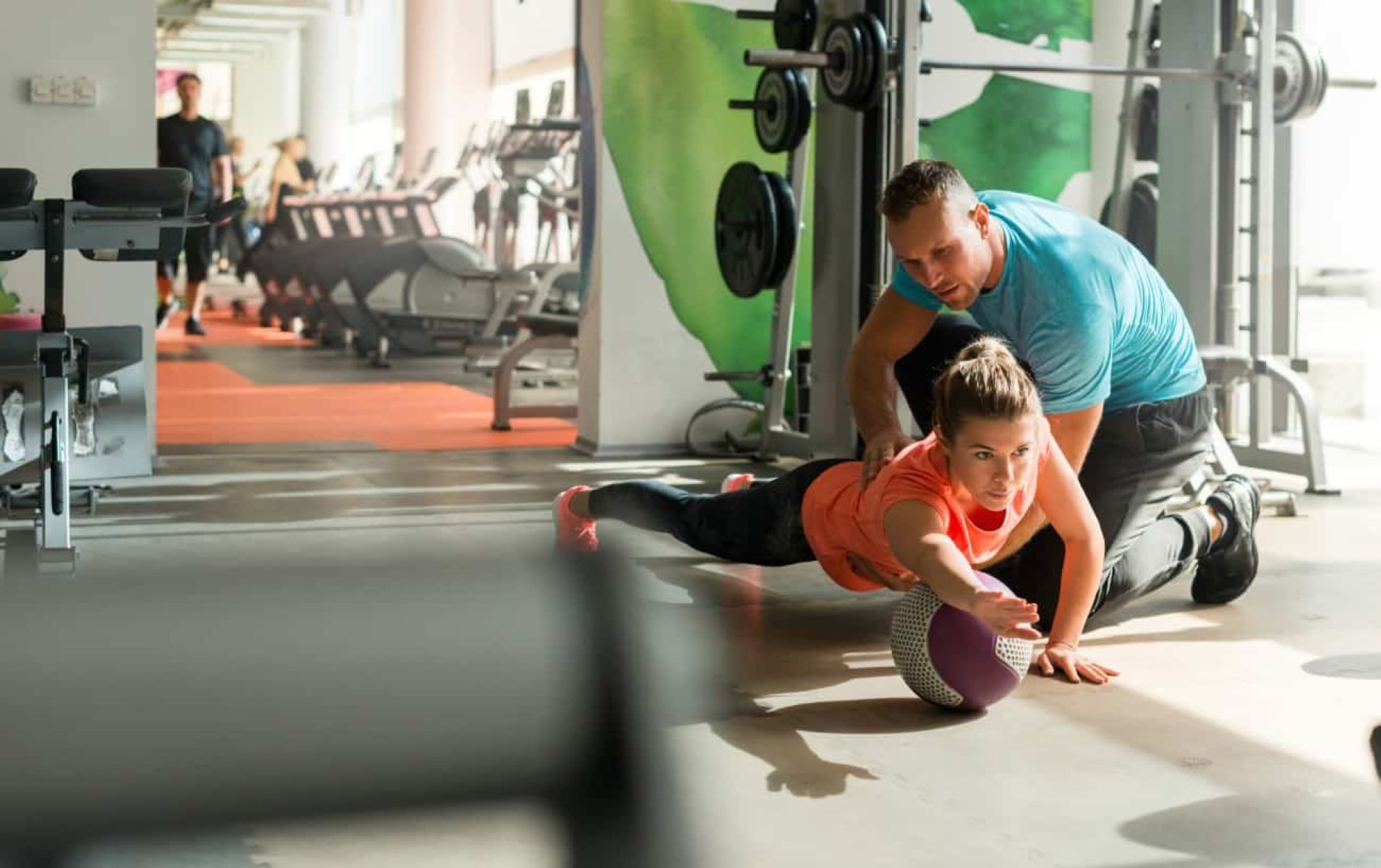

Featured
How Can I Get Better Stamina
Modified: August 21, 2023
Featured: Discover effective ways to improve your stamina and endurance. Unlock your full potential and achieve your fitness goals with our expert tips and strategies.
Introduction
Welcome to the world of fitness and endurance! Do you ever find yourself huffing and puffing after a flight of stairs or struggling to keep up with your favorite activities? If so, you’re not alone. Many people struggle with stamina, or the ability to sustain physical or mental effort for extended periods. Whether you’re an athlete aiming for peak performance or simply want to improve your everyday stamina, this article is for you.
Stamina plays a crucial role in our overall well-being. It affects our physical performance, mental focus, and even our quality of life. Having better stamina allows you to push through tough workouts, maintain energy throughout the day, and overcome challenges with ease. By enhancing your stamina, you can accomplish more and enjoy life to the fullest.
Fortunately, improving your stamina is within reach for anyone willing to put in the effort. In this article, we will explore various tips and strategies to help you boost your endurance and get closer to your fitness goals. From exercise routines to nutritional choices and rest techniques, we will cover a range of effective methods that can elevate your stamina to new heights.
But before we delve into these strategies, let’s first understand what stamina is and why it is important. By gaining this foundational knowledge, you’ll be better equipped to implement the right techniques and make meaningful progress in your fitness journey.
Understanding Stamina
Stamina refers to the ability of an individual to sustain physical or mental effort over a prolonged period. It is commonly associated with endurance and is crucial for performing both high-intensity activities and day-to-day tasks efficiently.
Physical stamina is often observed in athletes who engage in sports that require prolonged exertion, such as long-distance running, cycling, or swimming. It enables them to maintain their performance level and delay the onset of fatigue. Mental stamina, on the other hand, is essential for tasks that demand mental focus and concentration, such as studying for exams or working on complex projects.
Stamina is influenced by various factors, including cardiovascular fitness, muscular strength and endurance, respiratory capacity, and overall health. It can also be affected by lifestyle habits, such as nutrition, sleep patterns, stress levels, and hydration.
Improving stamina involves gradually increasing your body’s capacity to handle physical or mental stress. Over time, this leads to enhanced endurance, improved efficiency in oxygen utilization, and delayed fatigue. By understanding the components that contribute to stamina, you can tailor your approach to address specific areas and achieve optimal results.
Cardiovascular fitness plays a vital role in stamina. It refers to the ability of the heart and lungs to supply oxygen and nutrients to the muscles during prolonged physical activity. Regular cardiovascular exercise, such as running, swimming, or cycling, helps strengthen the heart and lungs, improving their efficiency and endurance.
Muscular strength and endurance are also critical for stamina. Strong muscles are more resistant to fatigue and can sustain efforts for longer periods. Incorporating strength training exercises, such as weightlifting or bodyweight exercises, into your routine can improve both muscular strength and endurance, leading to better stamina.
In addition to physical factors, mental and emotional stamina are equally important. Mental stamina involves the ability to sustain focus and concentration, especially during challenging tasks or stressful situations. Emotional stamina relates to resilience and the ability to cope with emotional stress or adversity. Practices such as meditation, mindfulness, and stress management techniques can help enhance both mental and emotional stamina.
Now that we have a solid understanding of what stamina entails, let’s explore the significance of having better stamina and how it can positively impact your life.
Importance of Having Better Stamina
Having better stamina offers a multitude of benefits that can improve various aspects of your life. Whether you’re an athlete or someone looking to enhance your everyday activities, investing in your stamina can be a game-changer. Let’s dive into the key reasons why having better stamina is important:
1. Enhanced Performance: Improved stamina allows you to perform at your best for extended periods. Whether it’s in sports, physical activities, or even workplace tasks, better stamina enables you to push through fatigue and maintain a high level of performance consistently.
2. Increased Energy Levels: When your stamina improves, so does your energy level. You’ll notice a significant boost in your overall vitality and endurance, enabling you to tackle daily tasks with vigor and enthusiasm. Say goodbye to feeling drained and exhausted halfway through the day!
3. Better Cardiovascular Health: By working on your stamina, you also improve your cardiovascular health. Regular exercise and endurance training strengthen your heart and lungs, reducing the risk of heart disease, high blood pressure, and other cardiovascular conditions.
4. Weight Management: Having better stamina can contribute to weight management and overall body composition. Engaging in activities that require sustained effort burns more calories and helps build lean muscle mass, assisting in weight loss or maintenance goals.
5. Mental Resilience: Improved stamina not only benefits your physical health but also has a positive impact on your mental well-being. It enhances mental resilience, enabling you to stay focused, handle stress more effectively, and persevere in the face of challenges.
6. Boosted Confidence: As you witness your stamina improving and achieve new physical milestones, your self-confidence naturally gets a boost. Knowing that your body is capable of enduring and accomplishing more can have a profound effect on your overall self-esteem.
7. Enhanced Quality of Life: Better stamina allows you to engage in a wider range of activities and hobbies without feeling exhausted or limited. Whether it’s participating in sports, going on adventures, or simply keeping up with the demands of daily life, improved stamina enhances your overall quality of life.
By understanding the importance of having better stamina, you can now appreciate the value of investing time and effort into improving it. In the next section, we will explore practical tips and strategies to help you boost your stamina effectively.
Tips to Improve Stamina
Improving stamina is a gradual process that requires dedication and consistency. By incorporating the following tips into your routine, you can boost your endurance and achieve better stamina:
-
Regular Exercise: Engage in regular physical activity to build endurance and improve stamina. Incorporate both cardiovascular exercises, such as running or swimming, and strength training exercises to enhance muscular strength and endurance.
-
Balanced Diet: Maintain a well-balanced diet that provides all the necessary nutrients to support your energy levels and endurance. Include a variety of fruits, vegetables, lean proteins, whole grains, and healthy fats in your meals.
-
Adequate Sleep: Restful sleep is crucial for muscle recovery and replenishment of energy levels. Aim for 7-8 hours of quality sleep each night to ensure your body is fully rejuvenated.
-
Interval Training: Incorporate interval training into your workouts to boost your cardiovascular stamina. Alternate between high-intensity bursts of exercise and periods of active recovery to challenge your body and improve its ability to sustain efforts.
-
Cardiovascular Activities: Engage in cardiovascular activities that specifically target endurance. These can include running, cycling, swimming, or any other activity that elevates your heart rate and challenges your cardiovascular system.
-
Strength Training: Include strength training exercises in your routine to improve muscle strength and endurance. Focus on compound exercises that work multiple muscle groups simultaneously, such as squats, lunges, and push-ups.
-
Mental and Emotional Strategies: Develop mental and emotional stamina by practicing stress management techniques, meditation, and mindfulness. These practices help enhance focus, resilience, and enable you to sustain mental effort for longer periods.
-
Hydration: Stay hydrated throughout the day to support optimal bodily functions and prevent fatigue. Maintain a habit of drinking enough water before, during, and after exercise.
-
Breathing Techniques: Learn and practice proper breathing techniques during exercise. Deep breathing helps oxygenate your muscles and improves stamina by enhancing your body’s oxygen utilization efficiency.
-
Rest and Recovery: Allow sufficient time for rest and recovery between workouts. Giving your body time to repair and rebuild is essential for improving stamina and avoiding overuse injuries.
Remember, improving stamina takes time, so be patient with yourself. Consistently incorporate these tips into your lifestyle, and you’ll gradually notice improvements in your endurance and overall stamina levels.
Regular Exercise
Regular exercise is one of the most effective ways to improve stamina and endurance. Engaging in physical activity on a consistent basis helps strengthen your cardiovascular system, build muscular endurance, and increase your overall stamina. Here are some key points to consider when incorporating regular exercise into your routine:
Consistency: Make exercise a regular part of your daily or weekly routine. Aim for at least 150 minutes of moderate-intensity aerobic activity or 75 minutes of vigorous-intensity aerobic activity spread throughout the week. Consistency is key to improving stamina over time.
Variety: Include a variety of exercises to target different muscle groups and engage different energy systems. Incorporate cardiovascular exercises like running, swimming, cycling, or dancing to enhance your cardiovascular stamina. Don’t forget to include strength training exercises like weightlifting or bodyweight exercises to improve muscular strength and endurance.
Progression: Gradually increase the intensity and duration of your workouts to challenge your body and make continual progress. Start with a comfortable level and progressively increase the intensity or duration of your exercise sessions as your stamina improves.
Interval Training: In addition to steady-state cardio, try incorporating interval training into your routine. Interval training involves alternating between high-intensity bursts of exercise and periods of active recovery. This method can help boost your cardiovascular fitness and increase your body’s ability to sustain efforts for longer durations.
Cross-Training: Consider incorporating cross-training into your exercise routine. Cross-training involves engaging in different types of exercises or sports to target various muscle groups and challenge your body in different ways. This can help prevent overuse injuries and improve overall stamina.
Warm-Up and Cool-Down: Always start your exercise sessions with a proper warm-up and finish with a cool-down routine. Warm-up exercises prepare your muscles and cardiovascular system for the upcoming workout, and cool-down exercises help your body recover gradually and prevent muscle soreness.
Listen to Your Body: Pay attention to your body’s signals and adjust your exercise intensity or duration accordingly. It’s important to challenge yourself, but also to be mindful of any pain or excessive fatigue that may indicate overexertion or potential injury.
By making regular exercise a priority and following these guidelines, you’ll not only improve your stamina but also experience numerous other health benefits. Remember to consult with a healthcare professional before starting any new exercise program, especially if you have any underlying health conditions or concerns.
Balanced Diet
Eating a balanced diet is essential for fueling your body and improving stamina. The food you consume provides the energy and nutrients needed to sustain physical and mental effort. Here are some key tips to keep in mind when it comes to maintaining a balanced diet:
Nutrient-Dense Foods: Focus on consuming foods that are rich in essential nutrients, including fruits, vegetables, whole grains, lean proteins, and healthy fats. These foods provide vitamins, minerals, antioxidants, and fiber, which are vital for energy production, muscle function, and overall health.
Carbohydrates: Include adequate carbohydrates in your diet, as they are the primary source of energy for your body. Opt for complex carbs like whole grains, legumes, and vegetables, which provide sustained energy and prevent blood sugar fluctuations.
Protein: Consume enough protein to support muscle repair and growth. Lean sources of protein, such as chicken, fish, tofu, beans, and lentils, are excellent choices. Protein helps build and repair tissues, including muscles, which is crucial for stamina improvement.
Healthy Fats: Incorporate healthy fats into your diet as they provide essential fatty acids and promote satiety. Include sources such as avocados, nuts, seeds, olive oil, and fatty fish, which are rich in omega-3 fatty acids and have anti-inflammatory properties.
Hydration: Stay adequately hydrated by drinking plenty of water throughout the day. Dehydration can lead to fatigue and reduced stamina. Carry a water bottle with you and sip water regularly, especially during and after exercise.
Avoid Excess Sugar and Processed Foods: Minimize your intake of sugary drinks, sweets, processed snacks, and fast food. These foods can cause energy crashes and negatively impact your overall health. Instead, opt for natural, whole foods that nourish your body and provide sustained energy.
Meal Planning and Timing: Plan and prepare your meals in advance to ensure you have nutritious options readily available. Aim for regular, balanced meals throughout the day to provide a steady supply of energy. Include a mix of carbs, protein, and healthy fats in each meal to optimize energy levels.
Listen to Your Body: Pay attention to how different foods make you feel. Each person’s dietary needs and tolerances are unique, so take note of how certain foods affect your energy levels and overall well-being. Adjust your diet accordingly to optimize your stamina.
A balanced diet not only provides the necessary fuel for improved stamina but also supports overall health and well-being. It’s important to work with a healthcare professional or nutritionist to ensure you’re meeting your individual nutritional needs based on your activity level, age, and any specific dietary considerations you may have.
Adequate Sleep
Adequate sleep is a critical factor in improving stamina and overall well-being. While we often focus on exercise and nutrition, it’s important not to overlook the power of quality sleep in optimizing our body’s energy and recovery processes. Here are some key points to consider when it comes to prioritizing sleep:
Sleep Duration: Aim for 7-8 hours of sleep per night, as recommended by experts. Everyone’s sleep needs may vary slightly, so listen to your body and adjust accordingly if you find that you need more or less sleep to feel refreshed and energized.
Sleep Schedule: Establish a consistent sleep schedule by going to bed and waking up at the same time each day, even on weekends. This helps regulate your body’s internal clock and promotes better sleep quality.
Optimal Sleep Environment: Create a sleep-friendly environment that is cool, quiet, and comfortable. Use blackout curtains or an eye mask to block out any sources of light, and consider using earplugs, a white noise machine, or soothing music to drown out disruptive sounds.
Pre-Sleep Routine: Develop a pre-sleep routine to signal to your body that it’s time to relax and prepare for rest. Engage in calming activities such as reading a book, taking a warm bath, or practicing relaxation techniques like deep breathing or gentle stretching.
Avoid Stimulants and Electronics: Limit your consumption of caffeine and avoid consuming it close to bedtime, as it can interfere with falling asleep. Additionally, minimize screen time in the hours leading up to bedtime, as the blue light emitted by electronic devices can disrupt sleep patterns.
Quality Mattress and Pillows: Ensure that your mattress and pillows provide proper support and comfort for a restful sleep. Invest in good quality bedding that promotes proper spinal alignment and alleviates pressure points.
Limit Napping: If you find that napping during the day affects your ability to fall asleep or stay asleep at night, limit or avoid daytime naps. Instead, focus on maintaining a consistent sleep routine and allowing for sufficient nighttime rest.
Manage Stress: Implement stress management techniques to help relax your mind before sleep. Engage in activities such as journaling, practicing mindfulness, or listening to calming music to promote a peaceful and restorative sleep experience.
By prioritizing quality sleep and adopting healthy sleep habits, you allow your body to recover and regenerate. Good sleep is essential for physical and mental performance, better concentration, and overall stamina improvement.
Interval Training
Interval training is a powerful method to improve stamina and boost cardiovascular fitness. This training technique involves alternating between periods of high-intensity exercise and periods of active recovery. Here’s what you need to know about incorporating interval training into your workouts:
Benefits of Interval Training: Interval training challenges your cardiovascular system by pushing it to work at higher intensities. This type of training stimulates the heart and lungs, improving their efficiency and increasing oxygen uptake. It also helps burn more calories than steady-state cardio and can enhance endurance faster.
Types of Interval Training: There are different ways to structure interval training routines. One common approach is high-intensity interval training (HIIT), where you perform short bursts of intense exercise followed by shorter recovery periods. Another option is called fartlek training, which involves alternating between different intensities throughout your workout, allowing for more flexibility in intensity and duration.
Personalization: Interval training can be tailored to your fitness level and goals. You can adjust the duration, intensity, and number of intervals based on your capabilities and progression. Beginners may start with shorter intervals and longer recovery periods, gradually increasing the intensity and reducing the recovery time as they build stamina.
Exercise Selection: Choose exercises that engage large muscle groups and elevate your heart rate. Running, cycling, rowing, and swimming are popular choices for interval training. However, you can also modify exercises like jumping jacks, burpees, or mountain climbers to fit your fitness level and equipment availability.
Work-to-Rest Ratios: Depending on your fitness level, you can experiment with different work-to-rest ratios. Beginners may start with a 1:3 or 1:2 work-to-rest ratio, performing high-intensity intervals for a shorter duration followed by longer recovery periods. As your stamina improves, you can gradually reduce the rest periods and increase the work portion to create a more intense workout.
Proper Warm-Up and Cool-Down: Begin your interval training session with a thorough warm-up to prepare your muscles and cardiovascular system for the upcoming intensity. Include dynamic stretches and light aerobic exercise to increase blood flow and loosen up your body. After completing your intervals, end the session with a cool-down, including low-intensity exercises and stretching.
Gradual Progression: It’s crucial to progress gradually to prevent injuries and avoid overexertion. Increase the intensity or duration of your intervals gradually over time, allowing your body to adapt and build stamina. Incorporate rest and recovery days into your training schedule to give your body time to repair and rejuvenate.
Interval training is an effective method for improving endurance and stamina by challenging your body to work at higher intensities. It’s a versatile form of exercise that can be modified to fit various fitness levels and preferences. Experiment with different interval training protocols to find what works best for you and enjoy the benefits of enhanced stamina and cardiovascular fitness.
Cardiovascular Activities
Cardiovascular activities are key in improving stamina as they specifically target the heart, lungs, and circulatory system. These exercises elevate your heart rate, improve oxygen utilization, and enhance endurance. Here are some important points to consider when incorporating cardiovascular activities into your routine:
Choose Activities You Enjoy: Select cardiovascular activities that you enjoy and look forward to. Whether it’s running, swimming, dancing, cycling, or playing a sport, engaging in activities you find enjoyable will increase your motivation and make it easier to stick to a routine.
Moderate Intensity: Aim for moderate-intensity aerobic activities that elevate your heart rate and breathing but still allow you to carry on a conversation. Gradually increase the duration and intensity of the activity as your stamina improves over time.
Frequency and Duration: The American Heart Association recommends at least 150 minutes of moderate-intensity aerobic activity or 75 minutes of vigorous-intensity aerobic activity per week. Spread these sessions throughout the week to give your body adequate time to recover and adapt.
Interval Training: Incorporate intervals of higher intensity within your cardiovascular workouts. Alternate between bursts of higher intensity and recovery periods to challenge your body and improve your stamina more rapidly.
Variety: Mix up your cardiovascular activities to engage different muscle groups and keep your workouts interesting. This not only prevents boredom but also helps develop overall fitness and stamina by targeting different energy systems.
Outdoor Activities: Take advantage of outdoor activities whenever possible. Running or biking outside can provide fresh air, natural scenery, and terrain variations, which can challenge your body in different ways and make your workouts more engaging.
Group Classes or Training: Consider joining group fitness classes or training programs. This not only adds a social aspect to your workouts but can also provide structure, motivation, and guidance from instructors or trainers who can help you improve your stamina effectively.
Progression: Gradually increase the duration, intensity, or difficulty of your cardiovascular workouts to continually challenge your body. This progressive overload helps build stamina and endurance over time.
Listen to Your Body: Pay attention to how your body feels during cardiovascular activities. Push yourself, but also be mindful of any signs of fatigue, dizziness, or pain. It’s important to know your limits and make adjustments accordingly to avoid overexertion and injuries.
Engaging in regular cardiovascular activities is crucial for improving stamina, boosting cardiovascular health, and increasing your overall endurance. Find activities that you enjoy, make them a consistent part of your routine, and watch as your stamina improves and you are able to tackle physical challenges with greater ease.
Strength Training
Strength training is an essential component of improving stamina. While cardiovascular activities focus on cardiovascular endurance, strength training helps build muscular strength and endurance, which are crucial for maintaining stamina during physical exertion. Here are key points to consider when incorporating strength training into your routine:
Varying Exercises: Include a mix of exercises that target different muscle groups to develop overall body strength. Compound exercises, such as squats, deadlifts, lunges, and push-ups, engage multiple muscle groups simultaneously and are effective for building both strength and endurance.
Progressive Overload: Gradually increase the intensity, resistance, or repetitions in your strength training exercises to continually challenge your muscles. This progressive overload principle stimulates muscle adaptation and helps improve muscular strength and endurance over time.
Full-Body Workouts: Incorporate exercises that target all major muscle groups, including the legs, core, back, chest, arms, and shoulders. A balanced and well-rounded strength training routine ensures that every muscle group is strengthened for better overall stamina and performance.
Include Circuit Training: Combine strength exercises with cardiovascular movements in circuit training sessions. This approach allows you to improve muscular endurance while maintaining an elevated heart rate, enhancing both strength and cardiovascular stamina simultaneously.
Proper Form and Technique: Focus on maintaining proper form and technique during strength training exercises to maximize effectiveness and prevent injuries. If you’re unsure, consider working with a certified personal trainer to ensure correct execution of exercises.
Recovery and Rest: Allow adequate time for rest and recovery between strength training sessions. Muscles need time to repair and rebuild after intense workouts. Including rest days or focusing on different muscle groups on alternating days allows for optimal recovery and prevents overexertion.
Gradual Progression: Increase the resistance, repetitions, or sets gradually, following the principle of progressive overload, to continuously challenge your muscles. This gradual progression helps improve strength and endurance over time, enhancing overall stamina.
Periodization: Consider incorporating periodization into your strength training routine. This involves dividing your training into specific phases, where you gradually increase intensity and volume, followed by periods of lower intensity for recovery. This structured approach can help prevent plateaus and optimize overall progress.
Balance with Cardiovascular Activities: While strength training is crucial for stamina improvement, it is important to also incorporate cardiovascular activities to enhance cardiovascular fitness. Striking a balance between strength and cardiovascular training will lead to comprehensive stamina improvement.
Strength training not only builds muscular strength and endurance but also plays a vital role in improving overall stamina. Incorporate strength training exercises into your routine, focusing on proper form, progressive overload, and adequate rest to maximize your stamina gains.
Mental and Emotional Strategies
Improving stamina goes beyond physical training; it also involves developing mental and emotional stamina. Strengthening your mental and emotional resilience can help you sustain focus, overcome challenges, and maintain motivation during demanding tasks or physical activities. Here are some strategies to enhance your mental and emotional stamina:
Positive Mindset: Cultivate a positive mindset by focusing on your strengths and accomplishments. Replace negative self-talk with affirmations and positive thoughts. This can help boost your confidence and maintain motivation during moments of physical or mental fatigue.
Goal Setting: Set realistic goals and break them down into smaller, achievable milestones. Chunking your goals into manageable steps helps maintain focus and provides a sense of accomplishment, enhancing your mental stamina as you progress towards your objectives.
Mindfulness and Meditation: Practice mindfulness and meditation to improve mental focus, reduce stress, and enhance emotional resilience. These techniques help train your mind to stay present, calm, and composed, even when faced with challenging situations or strenuous physical activity.
Stress Management: Implement stress management techniques such as deep breathing exercises, journaling, or engaging in hobbies to reduce stress levels. Chronic stress can deplete your energy and erode mental and emotional stamina, so it’s important to find healthy ways to manage stress effectively.
Visualization: Use visualization techniques to imagine yourself performing at your best and successfully overcoming challenges. Mental imagery has been shown to enhance performance and increase mental stamina by improving focus and boosting confidence.
Rest and Recovery: Prioritize rest and recovery to recharge your mental and emotional batteries. Allow yourself time away from high-intensity activities to relax, engage in leisure activities, and practice self-care. A well-rested mind is better equipped to handle physical and mental challenges.
Support Network: Surround yourself with a supportive network of friends, family, or like-minded individuals. Having a support system provides encouragement, motivation, and accountability, all of which contribute to improved mental and emotional stamina.
Resilience Building: Cultivate resilience by reframing setbacks as learning opportunities and focusing on solutions rather than dwelling on problems. Develop strategies to bounce back from obstacles, setbacks, or failures, strengthening your mental stamina in the face of adversity.
Self-Care: Prioritize self-care activities that promote mental and emotional well-being. Take time to engage in hobbies, practice relaxation techniques, spend time in nature, or engage in activities that bring you joy and rejuvenation. Taking care of your emotional needs enhances overall stamina and resilience.
By incorporating these mental and emotional strategies into your routine, you can improve your mental resilience, sustain focus, and enhance overall stamina. Remember that mental and emotional stamina go hand in hand with physical endurance in achieving peak performance in any aspect of life.
Hydration
Hydration is a key factor in improving stamina and overall performance. Staying properly hydrated is vital for maintaining energy levels, regulating body temperature, and supporting optimal physical and cognitive function. Here are important points to consider when it comes to hydration:
Water Intake: Drink an adequate amount of water throughout the day to maintain hydration. The recommended daily water intake varies depending on factors such as body size, activity level, and climate. Aim to drink at least 8 cups (64 ounces) of water per day and adjust based on individual needs.
Pre-Workout Hydration: Hydrate before starting any physical activity or exercise session. Drink water 1-2 hours before your workout to ensure your body is hydrated and ready for the upcoming exertion.
During-Workout Hydration: Stay hydrated during exercise by drinking water at regular intervals. If you’re engaged in prolonged or intense exercise, consider consuming a sports drink that contains electrolytes to replenish essential minerals lost through sweat.
Post-Workout Hydration: Rehydrate after your workout to replenish fluid lost through sweat. Drink water or a recovery beverage to restore hydration levels and support the recovery process.
Monitor Urine Color: Pay attention to the color of your urine as it can be an indicator of hydration status. Ideally, urine should be pale yellow to light yellow in color. If it is dark yellow or amber, it may indicate dehydration, and you should increase your fluid intake.
Heat and Humidity: In hot and humid conditions, the body tends to lose more water through sweating. Increase your fluid intake during these conditions to maintain proper hydration levels. Consider drinking water before, during, and after exercise to stay adequately hydrated.
Individual Hydration Needs: Everyone’s hydration needs vary, so it’s important to monitor your body’s signals and adjust accordingly. Factors such as body size, activity level, and sweat rate influence the amount of water you need to drink to stay properly hydrated.
Electrolyte Balance: Electrolytes, such as sodium, potassium, and magnesium, are essential for maintaining proper fluid balance in the body. If you engage in intense or prolonged exercise, consider consuming electrolyte-rich foods or beverages to help replenish these minerals.
Hydration Outside of Exercise: Remember that hydration is important even when you’re not exercising. Proper hydration throughout the day supports overall bodily functions and keeps you energized. Make it a habit to drink water regularly, even during non-exercise activities.
Incorporating proper hydration practices into your daily routine is crucial for improving stamina and optimizing performance. By staying adequately hydrated, you’ll have the energy, focus, and endurance necessary to tackle your physical activities and enhance your overall stamina.
Breathing Techniques
Breathing techniques play a significant role in improving stamina by enhancing oxygen delivery, reducing fatigue, and promoting relaxation. By incorporating proper breathing techniques into your exercise routine and daily life, you can optimize your stamina and performance. Here are some key points to consider:
Deep Belly Breathing: Practice deep belly breathing, also known as diaphragmatic breathing. This technique involves breathing deeply into your diaphragm, allowing your belly to rise with each inhalation and fall with each exhalation. Deep belly breathing helps increase oxygen intake and relaxes the body, reducing tension and promoting endurance.
Controlled Breathing During Exercise: Focus on controlled breathing patterns during exercise. Coordinate your breath with your movements, such as inhaling during the easier or less intense phases of the exercise and exhaling during the more challenging phases. This can help maintain a steady flow of oxygen to your muscles and enhance stamina.
Exhale on Effort: When engaging in activities that require exertion, such as weightlifting or pushing against resistance, remember to exhale during the effort phase. Exhaling during the exertion helps stabilize the core, improve muscular efficiency, and prevent unnecessary tension.
Rhythmic Breathing: Establish a rhythmic breathing pattern during cardiovascular activities. For example, adopt a pattern of inhaling for a certain number of counts and exhaling for the same number of counts. This rhythmic breathing technique can help regulate your breathing, reduce muscular tension, and improve endurance.
Practice Breath Control: Incorporate breath control exercises, such as box breathing or alternate nostril breathing, into your daily routine. These techniques help calm the mind, reduce stress, and improve focus, all of which can contribute to enhanced stamina and performance.
Breathing Recovery: After intense physical exertion, practice intentional deep breathing during your recovery period. This helps remove metabolic waste, regulate heart rate, and promote relaxation, aiding in the body’s recovery process and preparing you for subsequent efforts.
Awareness of Breathing: Develop an awareness of your breath throughout the day, not just during exercise. Practice mindful breathing by regularly taking a moment to focus on your breath and bring your attention to the present moment. This mindfulness helps reduce stress and improves mental resilience, which are crucial components of overall stamina improvement.
Guided Breathing Exercises: Utilize guided breathing exercises, such as meditation apps or videos, to help enhance your breathing techniques. These resources provide structured guidance to assist you in adopting proper breathing practices and can be useful tools in improving stamina and overall well-being.
By incorporating these breathing techniques into your routine, you can optimize your oxygen intake, reduce fatigue, and enhance overall stamina. Experiment with different techniques and find what works best for you, allowing you to fully harness the power of your breath for improved endurance and performance.
Rest and Recovery
Rest and recovery are essential components of improving stamina. Adequate rest allows your body to repair, rebuild, and adapt to the physical and mental stress placed on it during exercise and daily activities. Here are some key points to consider when it comes to rest and recovery:
Quality Sleep: Prioritize sufficient and high-quality sleep as a fundamental aspect of rest and recovery. Aim for 7-8 hours of sleep each night, ensuring that you consistently get enough restorative rest to support optimal stamina and overall well-being.
Rest Days: Incorporate regular rest days into your exercise routine. Plan days without intense exercise to allow your muscles, joints, and nervous system to recover from the physical stress of workouts. Rest days also help prevent overuse injuries and improve overall stamina in the long run.
Active Recovery: Engage in light, low-impact activities on rest days to promote blood circulation, muscle relaxation, and faster recovery. Examples include walking, gentle stretching, yoga, or low-intensity swimming. Active recovery helps reduce muscle soreness, improve range of motion, and speed up the recovery process.
Proper Nutrition: Fuel your body with adequate nutrients before, during, and after exercise to support recovery. Consuming a balanced diet that includes carbohydrates, protein, and healthy fats helps replenish energy stores, repair muscle tissue, and optimize recovery processes.
Hydration: Stay hydrated throughout the day, before, during, and after exercise, to support optimal recovery. Proper hydration aids in digestion, nutrient absorption, and the removal of metabolic waste, helping your body recover more efficiently.
Self-Care Practices: Incorporate self-care into your routine to promote mental and emotional rest as well. Engage in activities that help you relax and reduce stress, such as taking baths, practicing mindfulness or meditation, enjoying hobbies, or spending time in nature.
Listen to Your Body: Pay attention to the signals your body sends you. If you’re feeling excessively fatigued, experiencing persistent muscle soreness, or noticing a decline in performance, it may be a sign that you need more rest and recovery. Be mindful of these signals and adjust your routine accordingly.
Massage and Stretching: Consider incorporating massage therapy or self-massage techniques into your recovery routine. Massage helps relax muscles, improve circulation, and reduce muscle tension. Regular stretching also helps enhance flexibility, promote blood flow, and aid in muscle recovery.
Manage Stress: Implement stress management techniques to reduce mental and emotional stress. Chronic stress can impede recovery and hinder stamina improvement. Engage in activities such as meditation, deep breathing, journaling, or seeking support from friends and loved ones to manage and reduce stress levels.
Individualized Approach: Remember that rest and recovery needs vary from person to person. Factors such as age, fitness level, intensity of exercise, and overall health should be considered when establishing an individualized rest and recovery plan that supports your unique needs.
Rest and recovery are crucial for improving stamina, preventing burnout, and achieving optimal performance. By prioritizing and implementing adequate rest and recovery strategies, you provide your body with the time and resources it needs to heal, adapt, and strengthen, ultimately leading to improved stamina and overall well-being.
Conclusion
Improving stamina is a multifaceted process that requires attention to various aspects of physical and mental well-being. By incorporating the tips and strategies outlined in this article, you can enhance your stamina and enjoy the benefits of increased endurance, improved performance, and a better quality of life.
From regular exercise and balanced nutrition to proper hydration, rest, and recovery, each component plays a crucial role in building your stamina. Regular cardiovascular activities and strength training exercises help improve your physical endurance and muscular strength. Proper nutrition and hydration provide the fuel and hydration necessary to sustain energy levels and optimize performance.
In addition to physical aspects, mental and emotional strategies are key in developing mental resilience, maintaining focus, and overcoming challenges. Techniques such as mindfulness, positive thinking, and stress management contribute to enhanced mental stamina and overall performance.
Rest and recovery, including quality sleep and active recovery, are often overlooked but are vital in allowing your body to repair and rejuvenate. Prioritizing rest and recovery helps prevent overuse injuries, reduces fatigue, and optimizes your body’s recovery processes.
Remember, improving stamina is a gradual process, and it’s essential to listen to your body, adjust your routines as needed, and celebrate small victories along the way. It’s not just about reaching the finish line but enjoying the journey and embracing the progress you make.
So, whether you’re an athlete striving for peak performance, someone looking to conquer everyday challenges with ease, or simply seeking to improve your overall well-being, incorporating these strategies into your lifestyle will undoubtedly lead to improved stamina and a healthier, more vibrant you!









